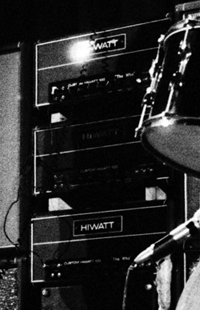John Entwistle’s Gear: 1968–1971
Overview of John Entwistle’s bass gear for the “Tommy” era, from late 1968 to mid-1971, including the famous Hiwatt rig and the Frankenstein Fender Precision Bass.
Bass guitars
-
“Frankenstein” 1965 Fender Precision Bass
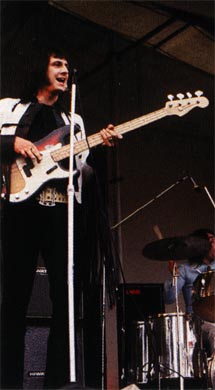
On stage, 30 Aug. 1969, second Isle of Wight festival, with the “Frankenstein” Fender Precision bass.
John’s primary bass guitar on stage through 1970, and in the studio through 1972, the 1965 sunburst (later refinished salmon pink) “Frankenstein” Fender Precision Bass.
JE: I put this together in San Francisco on a day off part way through a Who tour. It’s the remains of five smashed basses hence the name ‘Frankenstein’. In the mid 70’s it was retired from stage work so I had it refinished from sunburst into its present pink colour. I used this baby from 1967 onwards through ‘Tommy’ and all the tours up to ‘Quadrophenia’...The neck, pickups and circuitry are from a ‘dead’ slab bass, the tailpiece from a Jazz bass, the pickguard from a black P bass and the machine heads from 2 white P basses...Two hours with a Phillips screwdriver and a soldering iron and I was ranting around my hotel room screaming “It’s alive, it’s alive!”
For details, see 1967–1968.
-
Sunburst Fender Precision Bass with rosewood fingerboard
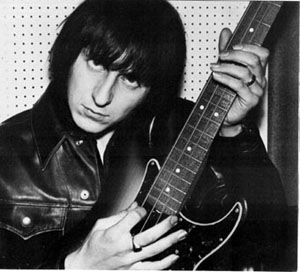
In the studio, ca. 1969, with Fender Precision bass with rosewood fingerboard.
John continued using a sunburst Fender Precision Bass with rosewood fingerboard, he had used on the road in 1968, as seen in recording studio photos from 1969.
-
Late ’60s black Fender Precision Bass with rosewood fingerboard
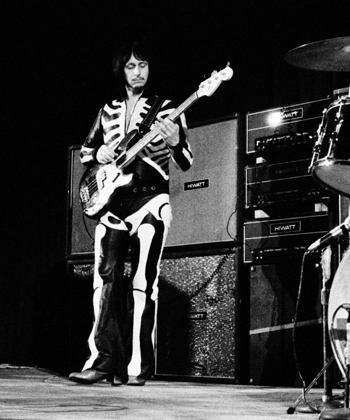
Click to view larger version. 20 Sept. 1970, Falkoner Centeret, Copenhagen, with four Hiwatt SE4122 or SE4123 4×12s and one Hiwatt customised DR103 and two Hiwatt CP103 amplifiers, playing late ’60s black Fender Precision Bass with rosewood fingerboard.
John used a late ’60s black Fender Precision Bass with rosewood fingerboard on the stage in 1970, notably seen at the third Isle of Wight Festival on 29 Aug. 1970.
-
1967 Rickenbacker 4005 (“Model 31”) bass in natural Mapleglo
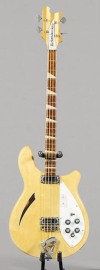
Click to view larger version. 1967 Rickenbacker 4005, from 2003 Sotheby’s auction. Estimated £1,200–£1,800. Sold for £7,200
- Serial no. GE 2208.
- Round-top body with chequer binding, “slash” soundhole, bound fingerboard with triangular markers.
- Acquired late 1968/early 1969.
- Used in studio, including The Seeker
- Used in television promos, including Beat Club, 1969 (for Tommy), and I Can See For Miles (on Pop Goes the Sixties, 1969)
- Sold in Sotheby’s auction, 2003. Estimated £1,200–£1,800. Sold for £7,200.
- Now featured on Björn Eriksson’s Rickenbacker Info.
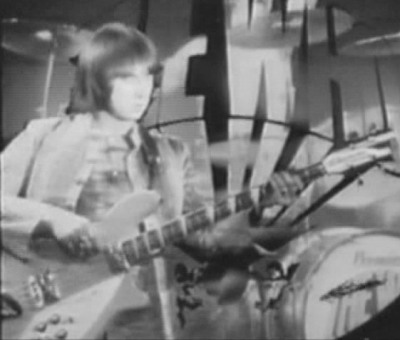
Ca. August 1969, from the Beat Club Tommy promo, with 1967 Rickenbacker 4005.
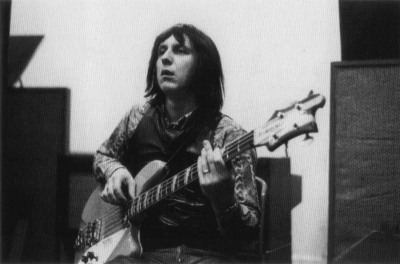
19 Jan. 1970, IBC Studios, recording the Seeker with 1967 Rickenbacker 4005.
-
Fender Precision in blue
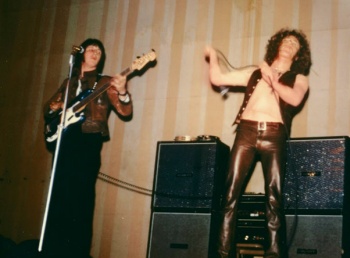
Click to view larger version 25 May 1969, photo of John playing a blue Fender Precision Bass with rosewood fingerboard.
John played a Fender Precision in blue, on 25 May 1969
-
1965–69 Gibson Thunderbird IV bass
John’s first use of a 1965–69 Gibson Thunderbird IV bass (“Non-Reverse”-style) for the Lifehouse run at the Young Vic in Spring 1971.
See Bass Gear 1971–1974.
Amplification
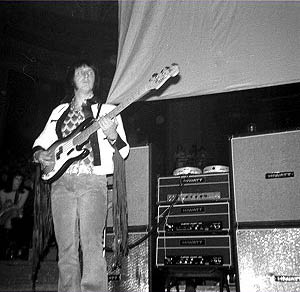
Sept. 29, 1969, Amsterdam, Concertgebouw. Showing Hiwatt rig: top, customised Sound City L100 amp badged as Hiwatt (unused, as spare); bottom two, customised Hiwatt DR103, customised to the CP103 four-channel specification (i.e., no “The Who” faceplate). Top cabinets are Hiwatt SE4123 4×12s; bottom two are Hiwatt SE4122 4×12 or Sound City 4×12 badged as Hiwatt. Courtesy The Who Netherlands Photo Gallery (offline). ©Henk Hulstkamp.
After having used Sound City L100 100-watt amplifiers on and off from April 1967, both John and Pete began exclusively using Sound City L100 amps customised to the CP103 spec, unbadged or badged as Hiwatt. Through 1969, John and Pete acquired more of these amplifiers, with the first “The Who” faceplate versions — CP103 — appearing in early 1970.
These amps were customised for Pete and John by Dave Reeves of Hylight Electronics, the maker of Hiwatt amplifiers (and who originally worked at Sound City, a division of Dallas Arbiter), presumably to what would be the CP103 specification.
-
Sound City:
- Two Sound City L100 amps customised to the CP103 spec, unbadged or badged as Hiwatt.
-
Controls, from left to right:
- Four inputs; Volumes 1, 2, 3, 4; Treble, Bass, Master Volume; Standby, Mains
Early versions had various block script Sound City nameplate badges, but beginning in late 1968, the badges were removed so that some were unbadged and some featured Hiwatt nameplate badges. Plus, control panel labels were taped over to further mask the Sound City origin.
-
- Two or four Sound City 4×12 cabinets with 50-watt Fane speakers.
- Two Sound City L100 amps customised to the CP103 spec, unbadged or badged as Hiwatt.
-
Hiwatt
- Amplifiers:
- Three Hiwatt DR103 100-watt amps customised to the CP103 spec (i.e., no “The Who” faceplate).
- Beginning early 1970: three Hiwatt CP103 100-watt amps. John also used two Hiwatt DR201 200-watt amps with one customised Hiwatt DR103 100-watt amp.
These amplifiers had no middle or presence controls, unlike the standard DR103.
Controls, from left to right: Four inputs; Volumes 1, 2, 3, 4; Treble, Bass, Master Volume; Standby, Mains.
Features: Five preamp valves (four 12AX7/ECC83 and one 12AT7/ECC81); four EL34output valves; Partridge transformers; four individual inputs (1 and 2 differently voiced brighter than 3 and 4) with four independent volume controls; 100 watts R.M.S. into an 8 ohm output impedance.
- Speaker cabinets:
- Four Hiwatt SE4122 or SE4123 4×12 cabinets.
- Two Hiwatt SE4151 4×15 cabinets and two Hiwatt SE4123 4×12 cabinets.
- Amplifiers:
For more details, see Sound City/Sound City badged as Hiwatt and Hiwatt CP103.
John Entwistle’s 1971 Hiwatt CP103 amp (serial no. 1705)
Hiwatt DR103 modified to CP103 specification that originally belonged to John Entwistle. Sold for £2,900 (approximately U.S.$4,800) via auction by Cooper Owen on 25 September 2003. Courtesy Hiwatt Story (dcsbulldog.tripod.com)
Click images to view larger versions. Courtesy Cooper Owen and the Hiwatt Story ( dcsbulldog.tripod.com)
Photo Gallery
Frankenstein
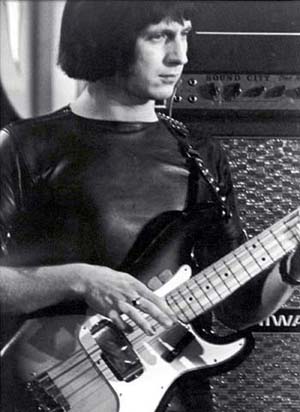
December 1968, from the Rolling Stones Rock & Roll Circus, closeup of John’s Sound City L100 amp badged as Hiwatt, showing CP103-style four-channel volume control. Speakers are Fane-loaded Hiwatt SE4122 4×12 or Sound City 4×12 badged as Hiwatt. Bass is “Frankenstein,” with chrome Fender Jazz pickup cover.
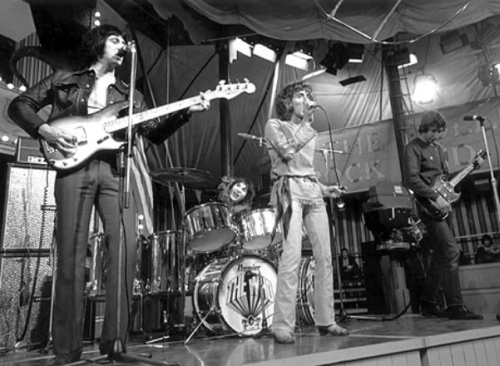
December 1968, from the Rolling Stones Rock & Roll Circus, John’s Sound City L100 amp badged as Hiwatt, through Hiwatt SE4122 4×12 or Sound City 4×12 badged as Hiwatt. Bass is “Frankenstein,” with chrome Fender Jazz pickup cover.

Sept. 29, 1969, Amsterdam, Concertgebouw. Showing Hiwatt rig: top, customised Sound City L100 amp badged as Hiwatt (unused, as spare); bottom two, customised Hiwatt DR103, customised to the CP103 four-channel specification (i.e., no “The Who” faceplate). Top cabinets are Hiwatt SE4123 4×12s; bottom two are Hiwatt SE4122 4×12 or Sound City 4×12 badged as Hiwatt. Courtesy The Who Netherlands Photo Gallery (offline). ©Henk Hulstkamp.
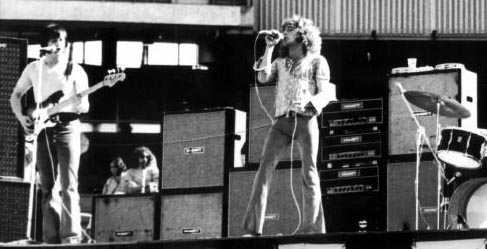
14 June, 1970, at Anaheim Stadium, Anaheim, Calif., showing Hiwatt rig, as well as the “Frankenstein” Fender Precision bass. Top and bottom amps are Hiwatt CP103; middle amp is Hiwatt DR103 customised to the CP103 spec (i.e., no “The Who” faceplate). Top cabinets are Hiwatt SE4123 4×12s; bottom two are Hiwatt SE4151 4×15s. Three other Hiwatt 4×12s are providing foldback from Pete’s rig.
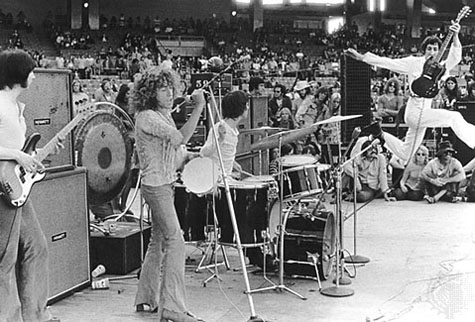
14 June, 1970, at Anaheim Stadium, Anaheim, Calif., showing Hiwatt rig, as well as the “Frankenstein” Fender Precision bass. Top cabinets are Hiwatt SE4123 4×12s; bottom two are Hiwatt SE4151 4×15s.
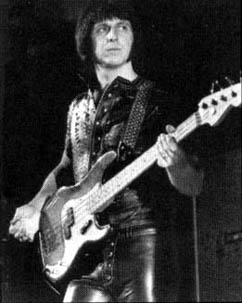
5 July 1970, Cobo Hall, Detroit, on stage with the “Frankenstein” Fender Precision bass.

On stage, 30 Aug. 1969, second Isle of Wight festival, with the “Frankenstein” Fender Precision bass.
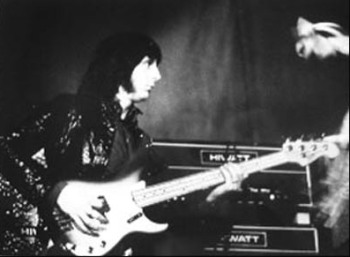
14 Feb. 1970, at Leeds University Refectory, with “Frankenstein” and Hiwatts.
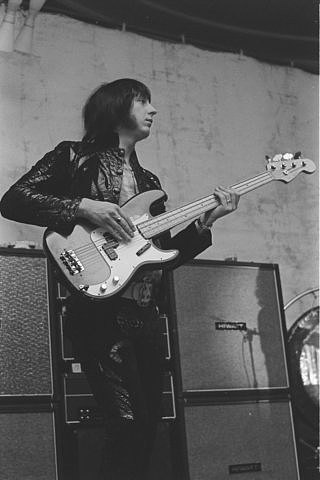
14 Feb. 1970, at Leeds University Refectory, with “Frankenstein” and Hiwatts.

Ca. 1969 or 1970, tuning up in the dressing room with the “Frankenstein” Fender Precision bass.
Fender Precision Bass in sunburst
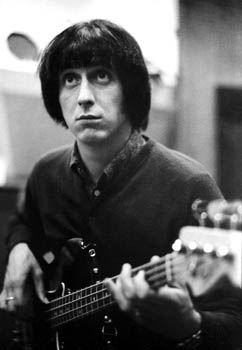
In the studio, ca. 1969, with Fender Precision bass with rosewood fingerboard.

In the studio, ca. 1969, with Fender Precision bass with rosewood fingerboard.
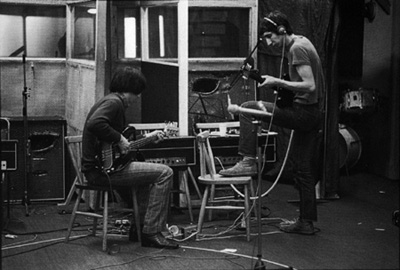
Ca. February–March 1969, recording sessions for Tommy, with both Pete and John using unlabeled customised Sound City L100 amplifier heads, with each amp driving one Sound City 4×12. John’s bass is the Fender Precision bass with rosewood fingerboard.
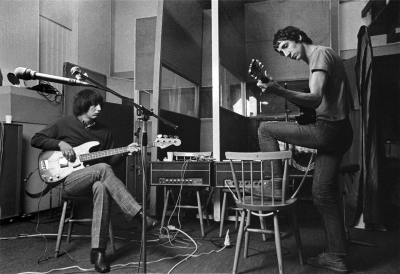
Click to view larger version. Ca. February–March 1969, recording sessions for Tommy, with Pete and John using unlabeled customised Sound City L100 amplifier heads each driving one Sound City 4×12. John’s bass is the Fender Precision bass with rosewood fingerboard.
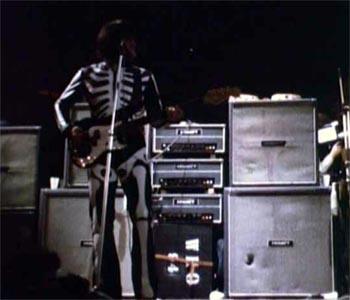
29 Aug. 1970, third Isle of Wight festival, with two Hiwatt SE4123 4×12s and two Hiwatt SE4151 4×15 cabinets, playing late ’60s black Fender Precision Bass with rosewood fingerboard.

20 Sept. 1970, Falkoner Centeret, Copenhagen, with four Hiwatt SE4122 or SE4123 4×12s and one Hiwatt customised DR103 and two Hiwatt CP103 amplifiers, playing late ’60s black Fender Precision Bass with rosewood fingerboard.
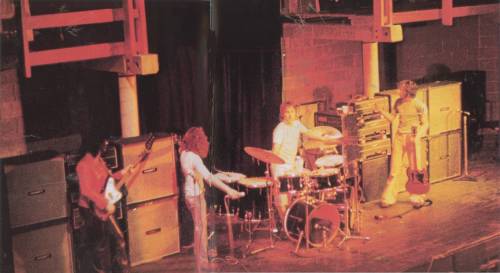
Ca. Spring 1971, Young Vic, with last uses of the Hiwatt rig, and first uses of the 1965–69 sunburst Gibson Thunderbird IV (“Non-Reverse”-style).
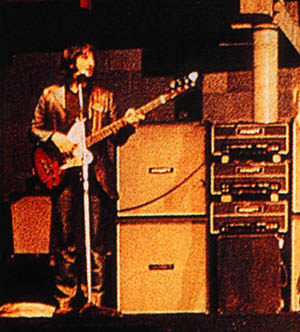
Ca. Spring 1971, Young Vic, with last uses of the Hiwatt rig, and first uses of the 1965–69 sunburst Gibson Thunderbird IV (“Non-Reverse”-style).
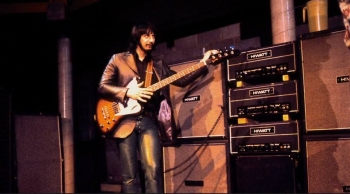
Click to view larger version. Ca. Spring 1971, Young Vic, with last uses of the Hiwatt rig, and first uses of the 1965–69 sunburst Gibson Thunderbird IV (“Non-Reverse”-style). Marshall PA cab visible at left.
1970/71 Hiwatt Custom Slave amp (serial no. 1319)
A Hiwatt Custom Slave amp featuring Who stencilling on the bottom, though there is no confirmation this was ever a Who-owned item, nor whether the Who employed this model in John’s bass rig or the PA. Item has seen considerable modification over the years, but the WHO stencilling is still visible at bottom of unit. Model STA200. Photos courtesy Christian A., Germany
Click images to view larger versions. Courtesy Christian A., Germany
Resources and Information
Contributors
Thanks to those who have made this page possible:
- Paul Winkler (pw_lists@slinkp.com)
- Brad Rodgers (whocollection.com)
- Jesse Pollack (Quarryman88@yahoo.com)
- Jake Kety
Additional Information:
- Brad Rodgers at whocollection.com
- Rock Stars Guitars, rockstarsguitars.com
- Sotheby’s May 2003 auction: sothebys.com
- Vintage Guitars Info: guitarhq.com/fender2.html#pbass
- Dr. Tube’s Schematics: drtube.com/guitamp.htm
- Sound City history & info: soundcitysite.com
- The Hiwatt Story, dcsbulldog.tripod.com
- Mark Huss’ Hiwatt Legacy: hiwatt.org
- PlexiPalace Vintage Amps Forum: vintageamps.com/plexiboard/viewforum.php?f=3 (archived)
- Unofficial Sunn Equipment: sunn.ampage.org/site/museum/ (archived)
- Includes “museum,” schematics and history.
- The Sunn Shack: richbriere.com/The_Sunn_Shack.htm (archived)
- Bass Culture, by John Entwistle; forewords by Roger Daltrey and Rick Nielsen. Published 2004 by Sanctuary Publishing
Manufacturer’s Links:
- Hiwatt USA (owned by Fernandes Guitars): hiwatt.com
- Hiwatt U.K. (owned by Music Ground): hiwatt.co.uk
- Fender: fender.com
- Marshall Amplification: marshallamps.com
- Sunn Amplification: sunnamps.com
- Rotosound Strings: rotosound.com
